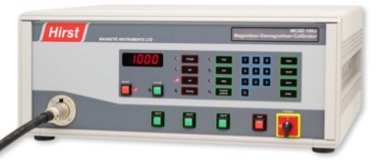
Hirst’s range of MCSD systems (Magnetiser Calibrator Setter Demagnetiser) are designed for the knockback, setting, calibrating, and treating of permanent magnets. These units offer functions that are known by various names including Magnet Treaters, Magnet Setters, Magnet Agers and Magnet Calibrators. The most common application for the MCSD range is for sensor manufacture. These are benchtop units that can be connected to other equipment or even a PC to calibrate magnets to specific levels. It is also possible to manually calibrate the magnets using the easy-to-use buttons on the front panel.
Why calibrate a magnet?
There may be several reasons for calibrating a magnet, the most common are
- Knock back for stability
- Calibration to a specific level
Certain grades of magnets, particularly AlNiCo magnets will exhibit an unwanted behaviour after magnetising. After fully magnetising the magnet, the magnet will slowly lose some of its magnetisation over time. To mitigate this effect, it is often necessary to knock back, or artificially age the magnet to put it into a stable state where it will no longer lose magnetisation. Terms for this including knock back, setting, calibrating or treating magnets.
Calibration for a specific level is another requirement. If the magnet is to be used in a sensor, or a moving coil meter, light aircraft compass or several other applications then its exact magnetisation level may be important. In this case the magnet is also knocked back until it achieves a desired level that is determined via external feedback such as a gaussmeter or fluxmeter.
The MCSD system
The MCSD series of precision microprocessor-controlled capacitor discharge Magnet, Charger, Setter, Demagnetisers (MCSD) has been designed as a flexible magnet processor for the laboratory and as the production workhorse for calibrating (stabilising, setting or ageing) all types of permanent magnets. There are two form-factors the MCSD 100J and 200J in a Benchtop-mini size and a larger format Bench-top Midi MCSD-500J and 800J. The Hirst MCSD range was first introduced in the 1980s and is in service in 100s of locations round the world. This is the 3rd generation of MCSD, and this generation was first introduced in 2020.
Modes of operation
Charge Mode is used to charge (saturate) magnets using a uni-directional pulse of energies up to the maximum allowable. The operator selects the operating voltage and the MCSD series discharges into the magnetising fixture whenever the pulse button is pressed. The capacitor voltage is displayed on the front panel during this process and can be altered at any time to a new value.
Demag Mode is used to demagnetise work pieces using a decaying sinusoidal waveform.
Set mode is used to set the flux level of a work piece to a particular value. This mode offers control of the demagnetising pulses. Demagnetising pulses are generated starting with the minimum voltage, the operating voltage being increased automatically by the selected step size after each pulse up to the selected maximum.
Cal mode is similar to set mode with the addition of an initial charge pulse of the maximum allowable energy. This pulse is used to saturate the work piece to a flux level greater than the final required flux level. The sequence of demagnetising pulses that follow the charging pulse can then be used to set the magnets to a correct flux level in one continuous overall operation
For information on the MCSD range see our magnetiser page.
Larger MCSD machines
MCSD functions can also be added to our larger range of magnetisers as custom products to meet your application – please contact us
